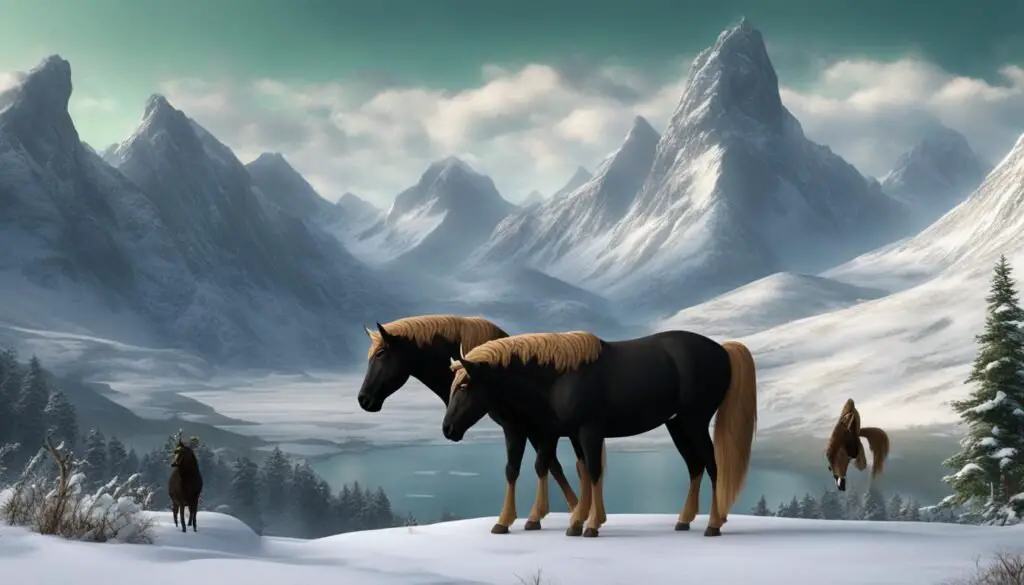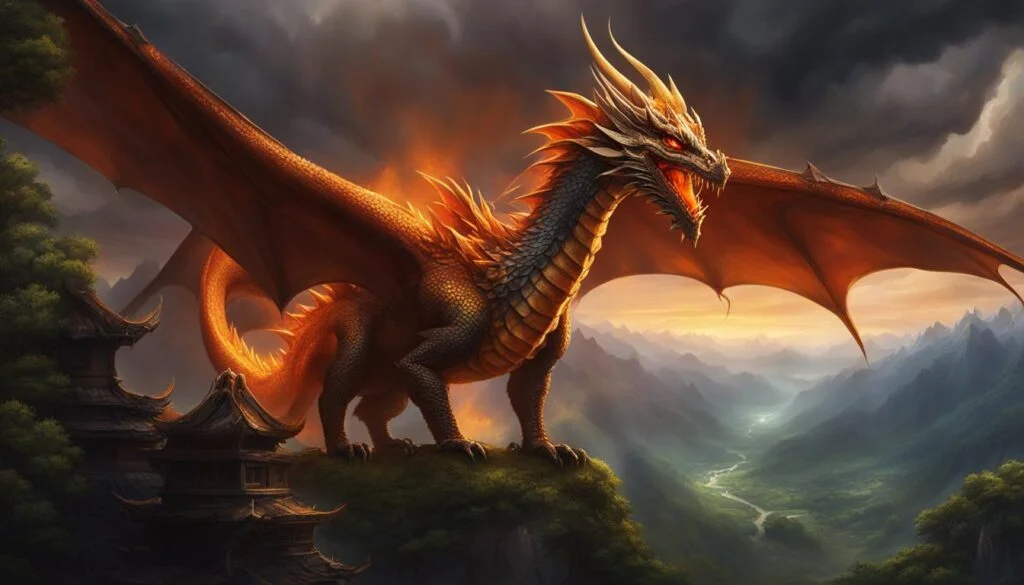When exploring ancient mythology, one cannot help but be fascinated by the intriguing creatures that inhabit these fantastical worlds. One such creature that captures the imagination is the Centaur, with its hybrid form of a human upper body and a horse’s lower body. But what about Norse mythology? Does it have its own version of these mythical beings?
Although Norse mythology is rich with gods, giants, and other mythical creatures, Centaurs do not have a direct presence in this mythological tradition. Norse mythology primarily focuses on its own pantheon of gods, the fierce giants, and the enigmatic elves. However, there may still be connections or themes that can be explored between Centaurs and Norse mythological concepts.
Key Takeaways:
- Despite its wealth of mythical creatures, Norse mythology does not include Centaurs.
- Norse mythology primarily focuses on gods, giants, and elves.
- Exploring connections or parallels between Centaurs and Norse mythology is an intriguing avenue to delve into.
The Etymology of Centaurs
The term “Centaur” is fascinating in its origins. However, there is no consensus on its etymology. Various theories have been proposed, each offering a different perspective on the meaning behind the name. Let’s explore the possible origins of this intriguing word.
Greek Connections
One theory suggests that the word “Centaur” may have connections to the Greek language. It potentially stems from the Greek words for “to pierce” and “wind,” implying a possible meaning of “Pokewind.” This connection could allude to the swift and powerful nature of the Centaurs.
A Link to Bulls?
Ancient folk etymologies have also linked the name “Centaur” to the Greek word for “bull.” This association could be rooted in the Centaurs’ strength and untamed nature, resembling the power and vigor of bulls.
Ancient Egyptian Influence
Another theory proposes that the name “Centaur” has connections to the ancient Egyptian word for “holy spirit.” This theory suggests a possible cross-cultural influence and highlights the diverse cultural inspirations that shaped ancient Greek mythology.
Alternatively, it is also possible that the name “Centaur” is euphemistic, an attempt to neutralize the creatures’ violent and terrible nature. This euphemism could serve to downplay the fearsome qualities often associated with Centaurs.
Understanding the etymology of Centaurs can provide insights into their cultural significance and mythical role. The various proposed origins of the name add layers of complexity to the Centaurs’ symbolism and character. Now that we have explored the origins of Centaurs, let’s delve deeper into their appearance and abilities in the next section.
The Appearance and Abilities of Centaurs
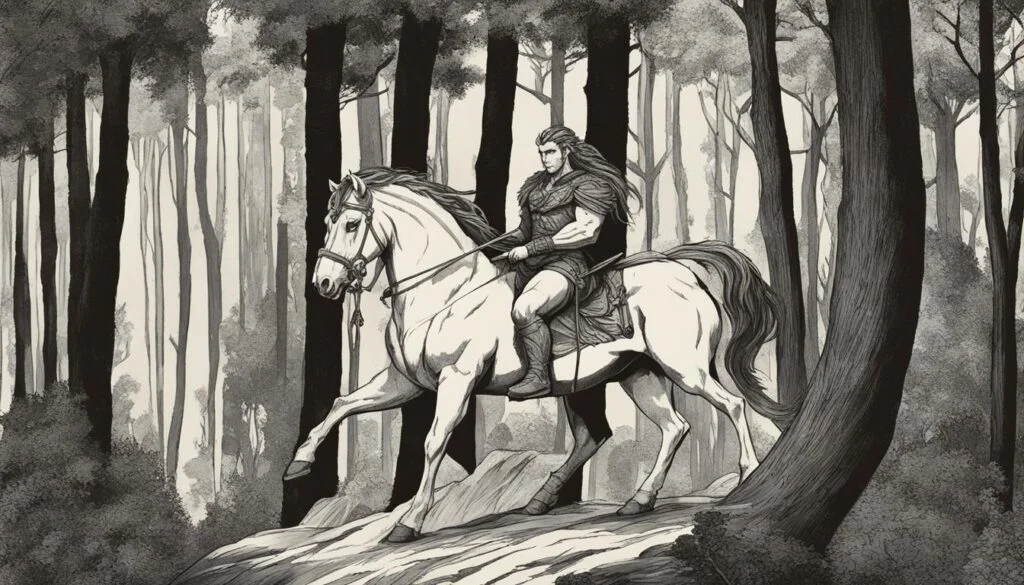
Centaurs, mythical creatures in Greek mythology, possessed a unique appearance that combined the upper body of a human with the lower body and four legs of a horse. Some variations of Centaurs even featured horns growing from their human heads, further emphasizing their unique attributes.
The combination of human and animal characteristics in Centaurs represented a fusion of animal aggression and human intellect. However, their aggressive nature often dominated, leading to their infamous reputation. Centaurs were known for their lustful behavior and were often depicted as forcefully carrying off and raping women. Their unrestrained behavior influenced their association with Dionysus, the god of wine and frenzy, as Centaurs had a tendency to lose control when consuming alcohol.
To further understand and appreciate the appearance and abilities of Centaurs, the image below offers a visual representation:
Centaurs in Greek Art and Iconography
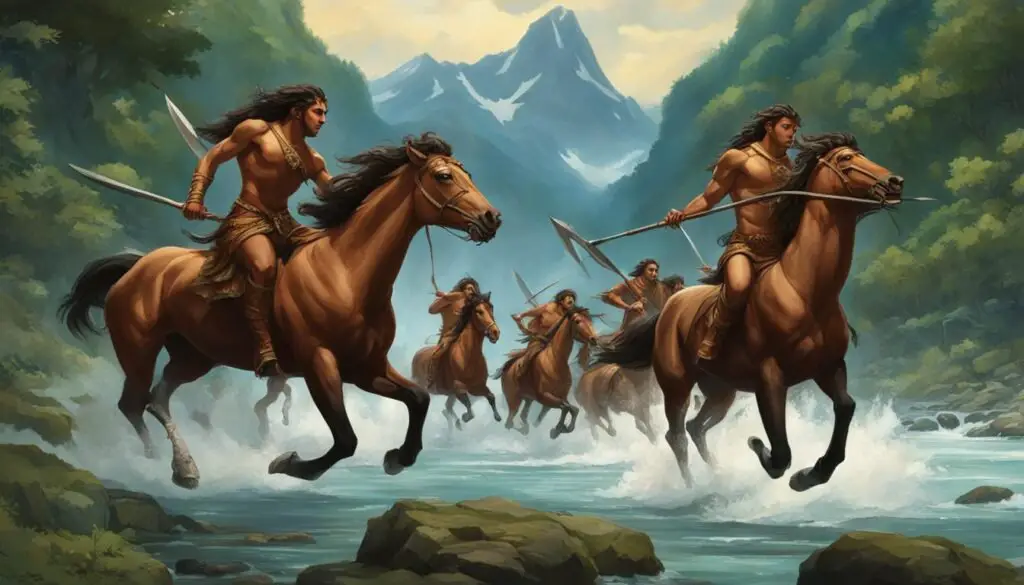
Centaurs have played a significant role in Greek art and iconography for centuries, showcasing their enigmatic and multifaceted nature. These mythical creatures, with the upper body of a human and the lower body of a horse, have captivated Greek artists since at least the tenth century BCE.
Early depictions of Centaurs in Greek art portrayed them as entirely human-like figures with a horse sprouting from their backs, symbolizing the fusion of two distinct identities. However, as the art form evolved, so did the representation of Centaurs, leading to the iconic image of a creature with the body and four legs of a horse becoming more prevalent by the late seventh century BCE.
Centaurs were often depicted in a manner that emphasized their savage nature. They were portrayed with features such as long hair, beards, and horse ears, highlighting their animalistic qualities. The inclusion of a snub nose further accentuated their bestial attributes, creating a visual contrast with the human-like upper body.
The “Centauromachy” was one of the most popular motifs in Greek art featuring Centaurs. This recurring theme depicted the intense battle between Centaurs and renowned heroes like Heracles or the Lapiths. It symbolized the eternal struggle between civilization, represented by the heroes, and the untamed forces of nature embodied by the Centaurs.
Centaurs in Roman Mythology and Art
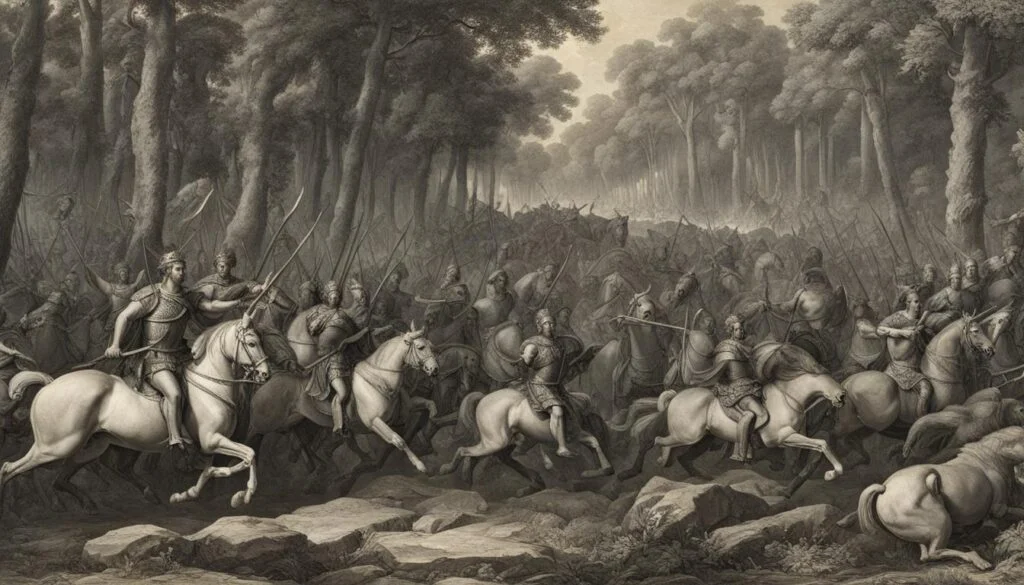
The Roman fascination with Centaurs led to their adoption of the Greek iconography with minimal alterations. In Roman art, Centaurs and Centauromachies, depicting the battle between Centaurs and heroes, can be found in various forms such as wall paintings, mosaics, sarcophagi, and engraved gems.
The Romans embraced the imagery and symbolism of the Centaur, considering them as both wild creatures and representatives of the perpetual struggle between the forces of order and chaos. These art pieces not only served as decorative elements but also conveyed deeper cultural and philosophical themes.
These Roman depictions of Centaurs in their mythology and art provide insight into how they were perceived and understood by ancient Roman society, shedding light on the interconnectedness of ancient mythologies and the enduring popularity of these mythical creatures.
Centaurs in Mythological Genealogy
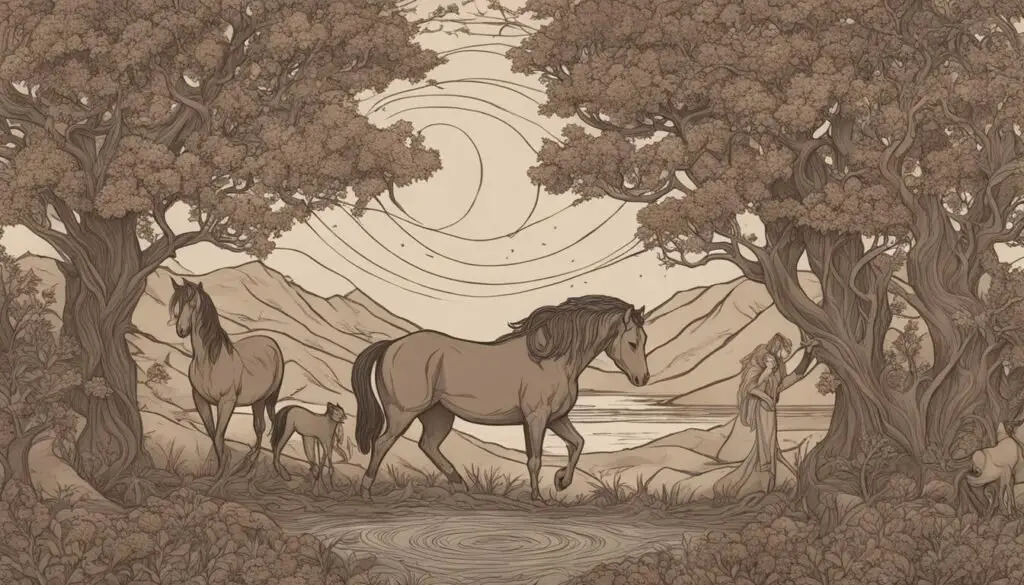
In Greek mythology, Centaurs have diverse and intriguing origins as described in various mythical traditions. The Centaur genealogy is filled with fascinating tales of their parentage and familial branches. Some of the prominent beliefs surrounding the birth and lineage of Centaurs are:
-
The union of Ixion, a mortal man, and Nephele, a cloud nymph, resulted in the birth of Centaurs. This tradition suggests a magical, mythical relationship between a human and a celestial being.
-
According to another tradition, Centaurs are regarded as the offspring of Centaurus, a man who engaged in mating with Magnesian mares. This origin story connects Centaurs directly to the equine world, blending human and horse characteristics.
It’s important to note that Centaurs possess distinct family branches and variations within their genealogy. Two notable categories are the Lamian Pheres and the Cyprian Centaurs, each with their own unique characteristics and mythological significance.
Visually exploring the Centaur family tree gives us a deeper understanding of their mythical origins and the complex interplay of human and equine aspects within their nature.
The Origins of Centaurs in Greek Mythology
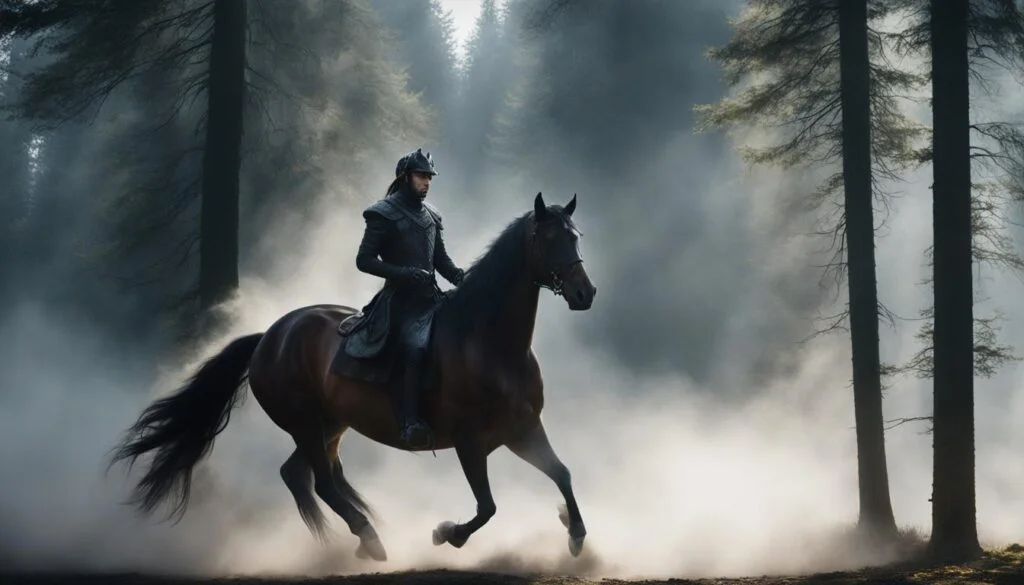
The myth of the Centaurs has long captured the imagination of Greek mythology enthusiasts. These fascinating creatures, with the combined features of humans and horses, have origins rooted in ancient Greek folklore and culture.
One theory suggests that the idea of Centaurs may have originated when early Greeks encountered horseback-mounted riders and interpreted them as a single creature combining human and horse features. This interpretation became the basis for the mythical Centaurs we know today.
Another theory proposes that Centaurs may have their roots in Indo-European mythology or may have been used as symbols of chaos and barbarism. These representations reflected the Greeks’ perception of creatures embodying untamed nature and the struggle between order and chaos.
Greek mythology offers various mythical traditions regarding the creation and origins of Centaurs. One such tradition involves Ixion, a mortal man who begot the Centaurs as his sons or grandsons. Another tradition suggests that they emerged from the union between the cloud nymph Nephele and Ixion.
Additionally, the Magnesian mares are mentioned in some versions of the Centaur origin myths. These mares may have played a role in the creation or lineage of the Centaurs, further adding complexity to their mythological heritage.
While the exact origins of Centaurs may not be definitively known, their mythological presence and unique characteristics continue to captivate and inspire. Theories and explanations surrounding their creation provide fascinating insights into the rich tapestry of Greek mythology.
Centaurs: A Mythological Enigma
- The myth of the Centaurs may have originated from horseback-mounted riders.
- They may have been symbols of chaos and barbarism.
- Greek mythology offers different traditions about the origins of Centaurs, involving Ixion, Nephele, Centaurus, and the Magnesian mares.
As we delve deeper into the fascinating realm of Greek mythology, the origins and creation of Centaurs serve as a reminder of the timeless allure and enduring mysteries that continue to captivate our imagination.
Centaur Mythology and Mythological Roles
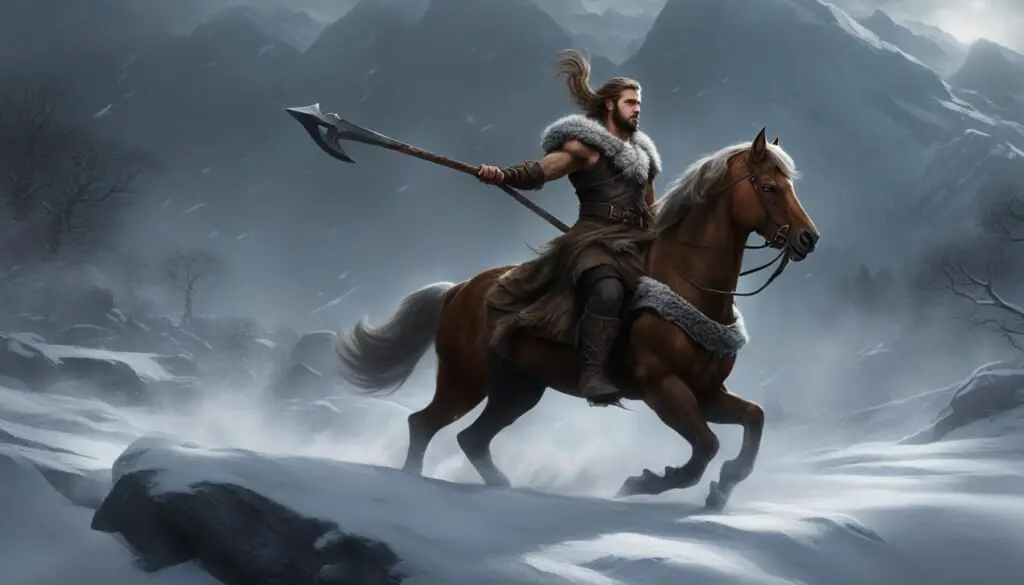
Centaurs are fascinating creatures in mythology, often portrayed as liminal beings situated between the realms of humanity and the animal kingdom. They embody the constant struggle between order and chaos, symbolizing the tension between civilization and untamed nature. One prominent mythological depiction of this struggle is the Centauromachy, a recurring theme that portrays the battle between Centaurs and the Lapiths.
Within Greek mythology, Centaurs also have individual roles and appearances in various mythological episodes. One notable Centaur is Chiron, known for his wisdom and intellect. Chiron served as a tutor and adviser to several heroes, including Jason and Achilles. His guidance and expertise were highly valued, representing the wise and knowledgeable aspect of Centaur mythology.
However, Centaurs aren’t always characterized as noble figures. Nessus, for example, was a brutish Centaur who infamously attempted to rape Heracles’ wife, Deianira. This portrayal showcases the darker and more violent side of Centaur mythology.
The symbolism of Centaurs extends beyond their roles in mythological narratives. They represent the eternal struggle between order and chaos, embodying the tension between civilized society and the wild forces of nature. The Centaur’s dual nature, with a human torso and a horse-like lower body, reflects this inherent duality.
The Significance of Centaurs in Greek Mythology
- Centaurs represent the struggle between civilization and wild nature.
- They embody the tension between order and chaos.
- Centaurs have individual roles and appearances in mythological episodes.
- Chiron, a wise and knowledgeable Centaur, acts as a tutor and adviser.
- Nessus, a brutish Centaur, showcases a darker side of Centaur mythology.
Centaurs in Norse Mythology
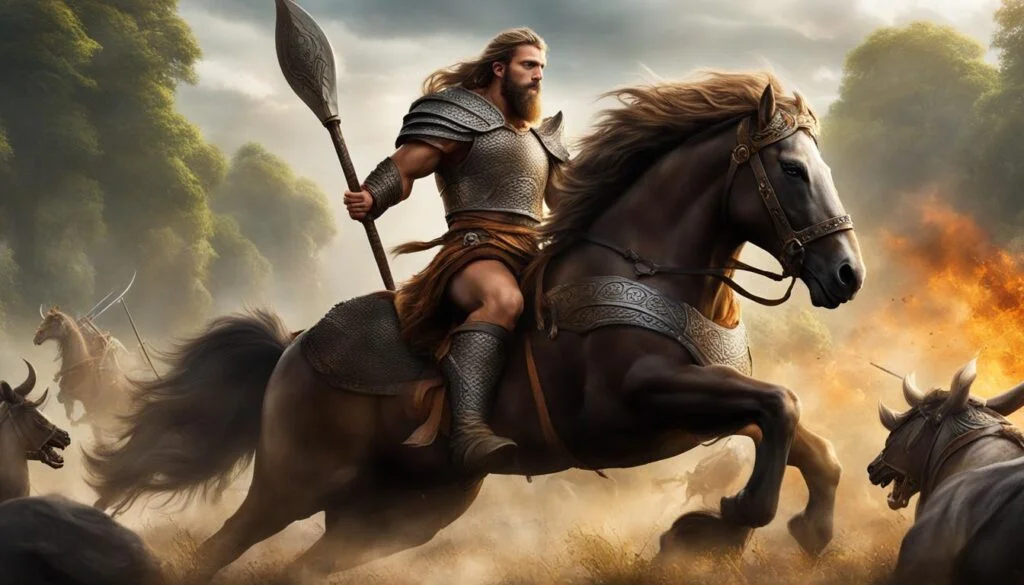
When exploring the rich tapestry of Norse mythology, one may notice the absence of centaurs, those mythical creatures with the upper body of a human and the lower body of a horse. Norse mythology primarily revolves around gods, giants, elves, and other beings unique to the Norse pantheon.
Unlike Greek mythology, where centaurs play prominent roles and are known as symbols of savagery and untamed nature, there is no specific mention or inclusion of centaurs in Norse tales or folklore. Norse mythology celebrates its own distinct mythological creatures, such as the mighty gods Thor and Odin, the fearsome giants like Jotnar, the mischievous tricksters like Loki, and the ethereal elves.
Although centaurs do not have a direct presence within Norse mythology, it is worth noting that there may be connections or parallels to explore between centaurs and Norse mythological themes. One can delve into exploring similar mythological motifs, symbolism, or representations of duality or opposition between civilization and wild nature found in both Greek and Norse traditions. This exploration can provide intriguing insights into the cultural and mythological exchanges that may have occurred during ancient times.
Centaurs and the Norse Worldview
- The absence of centaurs in Norse mythology signifies the uniqueness and distinctiveness of the Norse pantheon.
- Norse mythology primarily focuses on gods, giants, elves, and other beings that reflect the Norse worldview and values.
- Examining the reasons behind the absence of centaurs can shed light on the cultural and symbolic significance of various mythological creatures in Norse mythology.
Exploring Other Norse Mythological Creatures
- Norse mythology offers a vast array of fascinating creatures, such as the mighty dragon Nidhogg, the nine worlds-bearing serpent Jormungandr, and the shape-shifting trickster Loki.
- Delving into the characteristics, roles, and interactions of these creatures allows for a deeper understanding of the Norse mythological cosmos.
- Various creatures in Norse mythology embody different aspects of the natural and supernatural realms, offering insights into the cosmology and beliefs of the ancient Norse people.
In summary, centaurs do not directly feature in Norse mythology. The focus of Norse tales lies in the gods, giants, elves, and other unique mythological beings that populate the Norse pantheon. However, exploring the connections and possible parallels between centaurs and Norse mythological creatures can lead to fascinating insights into the cultural exchange and interplay between different mythological traditions.
Connections Between Centaurs and Norse Mythology
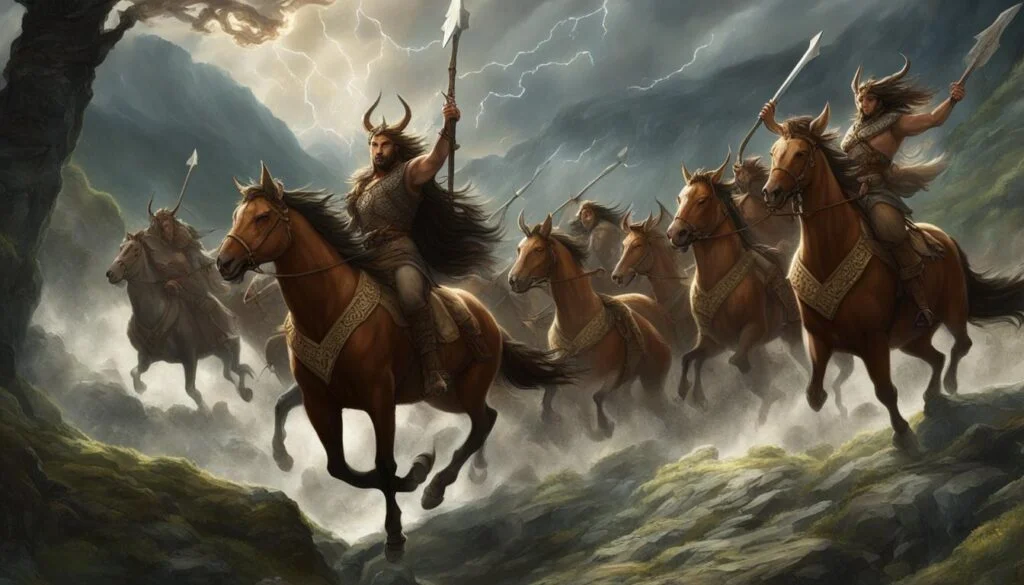
Although Centaurs do not have a direct presence in Norse mythology, it is intriguing to explore potential connections or parallels between Centaurs and Norse mythological creatures or themes. By examining similar mythological motifs and the symbolic representation of duality or opposition between civilization and wild nature in both Greek and Norse traditions, we can uncover fascinating insights.
In Greek mythology, Centaurs often represented the struggle between order and chaos, frequently depicted in the intense Centauromachy battles. Similarly, Norse mythology also explores the tension between different forces, such as the dichotomy between gods and giants or the delicate balance between the realms of Asgard and Jotunheim.
While Centaurs may not be explicitly mentioned in Norse tales or folklore, there might be mythological creatures or episodes that share common themes or characteristics with Centaurs. For example, the Norse gods’ association with animals, like Odin’s companions, the ravens Huginn and Muninn, or Freyr’s boar Gullinbursti, could bear similarities to the animalistic nature of Centaurs.
Centaurs and Horsemanship in Norse Culture

Norse culture, particularly in realms such as Thessaly, had a strong tradition of cavalry and horsemanship. The Norse people were skilled riders and valued the bond between humans and horses. Interestingly, the concept of centaurs, mythical creatures with the body of a horse and the upper body of a human, can be connected to Norse horsemanship.
Centaurs, with their horse-like lower bodies, symbolize the skills and craftsmanship associated with horses and riding. They embody the harmony and unity between human and equine, representing the ideals of a skilled horseback rider. As legendary riders themselves, centaurs provide an intriguing connection to the equestrian culture in Norse society.
Role of Centaurs in Norse Horsemanship
In Norse mythology, centaurs do not have a direct presence. However, their presence in Greek mythology and their association with horsemanship can inspire exploration of similar themes in Norse culture.
While there may not be specific tales or folklore involving centaurs in Norse mythology, the symbolism and attributes associated with these creatures can be examined in the context of legendary riders and horsemanship in Norse culture. Exploring the role of centaurs in Norse horsemanship can provide fascinating insights into the importance of horses and riding in Norse society.
Significance of Centaurs as Horseback Riders
The representation of centaurs as skilled horseback riders reinforces the deep-rooted connection between humans and horses in Norse culture. Centaurs, with their half-human, half-equine form, mirror the expertise and grace of the accomplished equestrian. They serve as a reminder of the importance of excellent horsemanship and the bond between rider and horse in Norse society.
By studying the symbolism and representation of centaurs in relation to horsemanship, we can gain a deeper understanding of the cultural significance and appreciation for horses and their riders in Norse culture.
- Centaurs embody the skills and craftsmanship associated with horses and riding.
- They represent the harmony and unity between humans and equines.
- Exploring the role of centaurs in Norse horsemanship provides insights into the significance of horses and riding in Norse society.
- As skilled riders themselves, centaurs symbolize the expertise and grace of horseback riding in Norse culture.
Conclusion
In conclusion, the realm of Norse mythology lacks direct references to Centaurs, the fascinating hybrid creatures that prominently feature in Greek mythology. Norse mythology, with its own distinct pantheon of gods, giants, and creatures, offers a rich and unique mythological tradition that is separate from Centaur folklore. Although there may be potential connections or parallels to explore between Centaurs and Norse mythological themes, it is crucial to appreciate the individuality and specificity of Norse mythos.
While Centaurs symbolize the clash between civilization and untamed nature in Greek tradition, Norse mythology focuses on different aspects of the natural and supernatural realms, exploring its own array of mythical creatures. These include gods like Odin, Thor, and Loki, as well as other fantastical entities such as giants, elves, and dwarves.
Although Centaurs do not have a direct presence within Norse mythology, it can be intriguing to investigate the intersections between Centaurs and Norse horsemanship, considering the strong tradition of cavalry and equine expertise in Norse culture. By exploring the significance of Centaurs as horseback riders and their potential connections to legendary riders in Norse sagas, we can gain further insights into the cultural symbolism and craftsmanship associated with horsemanship within the Norse context.
In summary, while Centaurs may not have a direct place in Norse mythology, their presence in Greek mythology offers a captivating glimpse into the realm of hybrid creatures and their symbolic representations. Understanding the distinctiveness of Norse mythos and appreciating its own unique pantheon is essential to exploring the rich tapestry of Norse mythology and the captivating creatures that populate it.
FAQ
Does Norse mythology include centaurs?
No, centaurs do not have a direct presence in Norse mythology. Norse mythology primarily focuses on gods, giants, elves, and other creatures unique to the Norse pantheon.
What are centaurs?
Centaurs, also known as Hippocentaurs, are hybrid beings in Norse mythology with the upper body of a human and the lower body and four legs of a horse.
What do centaurs represent in Norse mythology?
Centaurs are not present in Norse mythology. However, in Greek mythology, they are often depicted as symbols of everything that stands against culture and civilization.
Are there any mythical creatures in Norse mythology?
Yes, Norse mythology includes various mythical creatures such as dragons, giants, dwarves, elves, and trolls.
What is the origin of the name “centaur”?
The etymology of the term “centaur” is uncertain. It may be connected to the Greek words for “to pierce” and “wind,” suggesting a meaning of “Pokewind.” Another theory suggests that the name comes from the ancient Egyptian word for “holy spirit.”
How are centaurs depicted in Greek art?
Centaurs were often depicted with the torso, arms, and head of a human and the body and four legs of a horse. Some variations showed centaurs with horns growing from their human heads, long hair, a beard, horse ears, and a snub nose.
What was the significance of centaurs in Roman mythology?
The Romans embraced the symbolism of centaurs as both wild creatures and representatives of the perpetual struggle between the forces of order and chaos.
Who were the parents of centaurs in Greek mythology?
In Greek mythology, there are different mythical traditions regarding the origins and parentage of centaurs. One tradition suggests that centaurs were born from the union of Ixion and Nephele, a cloud nymph. Another tradition states that centaurs were the offspring of Centaurus, a man who mated with Magnesian mares.
Are there any connections between centaurs and Norse mythology?
While centaurs do not have a direct presence in Norse mythology, there may be connections or parallels to explore between centaurs and Norse mythological creatures or themes. This could involve examining similar mythological motifs or the symbolic representation of duality or opposition between civilization and wild nature in both Greek and Norse traditions.
Was horsemanship significant in Norse culture?
Norse culture, particularly in realms such as Thessaly, had a strong tradition of cavalry and horsemanship. Centaurs, as creatures with a horse-like lower body, can symbolize or represent the skills and craftsmanship associated with horses and riding.
Are there centaur-like creatures in Norse mythology?
No, there are no centaur-like creatures specifically mentioned or included in Norse mythology.


